Abstract
In this article, we find the solutions to fractional Volterra-type integral equation nonlinear systems through a Chebyshev pseudo-spectral method (CPM). The fractional derivative is described in the Caputo manner. The suggested method’s accuracy and reliability are confirmed by the results. The proposed method is implemented for solving various nonlinear systems; the results we obtained were compared with the exact solution and other method solutions. The graphical representation and tables show that our method’s error quickly converges as compared to other methods. By comparing the proposed method’s solution with the actual solution and other methods, we can confirm that CPM is more accurate and closer to the exact solution. We display the pointwise solution in the tables, which verifies the proposed method’s accuracy at each point and aids in a better comprehension of the suggested approach. Moreover, the results of using the suggested method at different fractional orders are examined, showing that when a value moves from a fractional order to an integer order, the result is closer to the precise solution. Furthermore, the proposed technique for handling fractional-order linear and non-linear physical problems in science and engineering is straightforward to implement.
1. Introduction
Fractional-order calculus has been around for as long as integer-order calculus. It can be seen in a letter by Leibniz to L’Hopital on 30 September 1695. To this day, the question about , the Leibniz notation of the nth derivative of the linear function appears in a letter from L’Hopital. L’Hopital strangely inquired, “What will be the result if ”, to which Leibniz responded, “An seeming paradox, one day for which a useful result will be drawn”. The integer-order calculus is generalized to the fractional order calculus. Fractional calculus applications include anomalous transports in disordered systems [1], the time-fractional Belousov–Zhabotinsky reaction [2], dielectric relaxation phenomena in polymeric materials [3], long-time memory in a financial time series [4], and transport dynamics in a system governed by anomalous diffusion [5].
Many somatic problems in real life may be demonstrated using mathematical formulations, which convert physical occurrences into sophisticated mathematical formulae. Differential equations are used to simulate various physical phenomena, such as population growth or decay models [6,7,8]. However, some physical phenomena cannot be adequately represented using integer-order differential equations. As a result, the researchers created a new branch of mathematics known as fractional differential equations (FDEs). In comparison to integer-order differential equations, FDEs are employed to accurately simulate a variety of physical phenomena. In recent years, FDEs have gained prominence in the modeling of real-world physical problems, such as colored noise [9], economics [10], earthquake oscillation [11], and bioengineering [12]. The other applications are control theory [13], rheology [14], signal processing [15], damping method [16], polymers [17], and so on [18,19,20,21,22]. Mathematicians are interested in the solutions to these FDEs in order to obtain the objective solution of mathematical models. Analytical and numerical solutions are the most common forms of solutions. However, the analytical solutions we obtain are complex and final for all real-world problems. As a result, mathematicians solve these issues with approximate solutions [23,24]. Symmetry analysis is lovely to study when studying differential equations, more specifically when studying equations from the mathematics of finance. The secret to nature is symmetry, but most observations in the natural world lack it. A powerful technique for disguising symmetry is the occurrence of spontaneous symmetry-breaking. Finite and infinitesimal are two types of symmetries. Finite symmetries may be continuous or discrete. While parity and temporal reversal are discrete natural symmetries, space undergoes continuous modifications. Mathematicians have always been fascinated by patterns. Classifications of spatial and planar patterns made significant achievements in the eighteenth century.
Every branch of engineering and science uses fractional integral- and integro-differential equations. When a physical phenomenon is described using differential equations, the result is a differential equation, integro-differential equation, or integral equation. With these types of equations, some applications are glass-forming processes [25], nanohydrodynamics [26], drop-wise condensation [27], or wind ripples in the desert [28]. In most circumstances, there is no analytical solution to integral- or integro-differential equations. It is difficult to find, even if it exists in some circumstances. For approximating the solutions of integral- and integro-differential equations, various numerical approaches have been developed. To solve these challenges, a variety of approaches have been used, such as the nonstandard difference method (NDM) [29], Adams–Bashforth–Moulton method (ABMM) [30], homotopy analysis method (HAM) [31], generalized differential transform method (GDTM) [32], mixed interpolation collocation method (MICM) [33], collocation method (CM) [34], iterated Galerkin method (IGM) [35], spline collocation method (SCM) [36], Legendre wavelet method (LWM) [37], Newton polynomial (NP) [38], predictor–corrector (PC) [39], and Galerkin method (GM) [40].
To calculate the solutions of FIDEs in this study, we applied a new technique called the Chebyshev pseudo-spectral method (CPM). Our method reduces the proposed models to linear/non-linear systems of algebraic equations, considerably simplifying the problems; an appropriate method is then utilized to solve the resulting system. When compared to other methods, the suggested method has higher accuracy and better convergence. The numerical results show that the suggested technique is effective and reliable. In addition, CPM can be used in a variety of other physical models.
2. Definitions and Preliminaries Concept
This unit introduces the fundamental concepts related to fractional calculus.
Definition 1.
A real function will be in the space if a real number exists , with where and will be in the space if and only if .
Definition 2.
The fractional Caputo derivative of order α is stated as [41,42]
for , , , .
Definition 3.
Jin-Hunan’s fractional derivatives are referred to as [42]
where does not approach zero.
Definition 4.
Xiao-Jun defines fractional order derivatives as [42]
where
Definition 5.
The integral operator in the Riemann–Liouville sense is stated as [41,42]
with the following properties
3. Chebyshev Pseudo-Spectral Method (CPM)
Chebyshev polynomials are defined as the interval and are demonstrated using recurrence equations [43,44].
where
In order to apply the Chebyshev polynomials in the interval , Chebyshev’s shifted polynomials are described as , which explains (in the same way) the Chebyshev polynomials by relation
The recurrence formula is as follows
where
In terms of Chebyshev’s shifted polynomials, a function is described as
The first (m + 1) terms of Chebyshev’s shifted polynomials are considered as
We have the ability to find a system of equations as
Whereas
We used maple software to solve the resultant system, which provides a CPM solution.
4. Applications
Example 1.


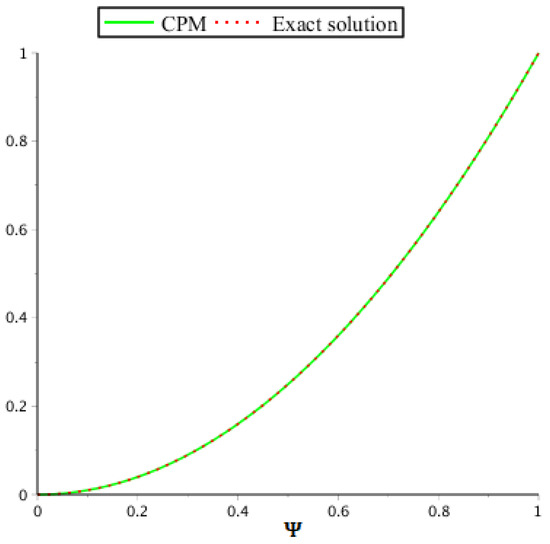
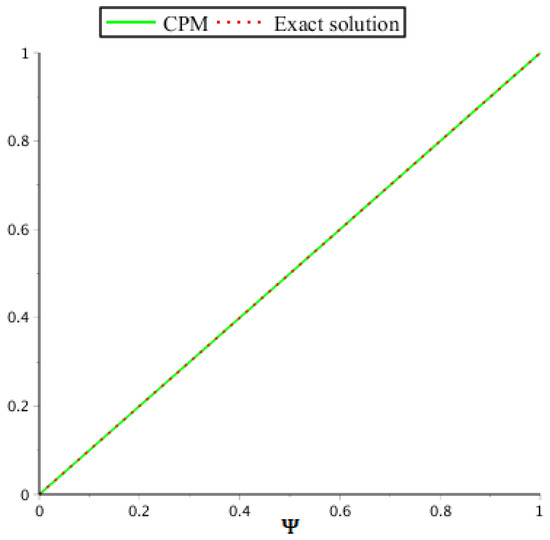
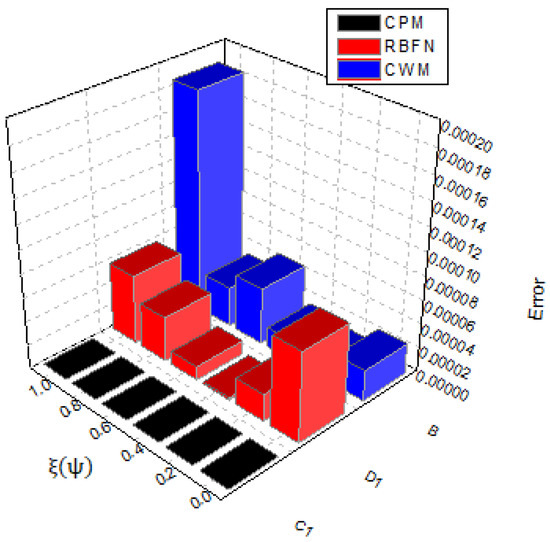
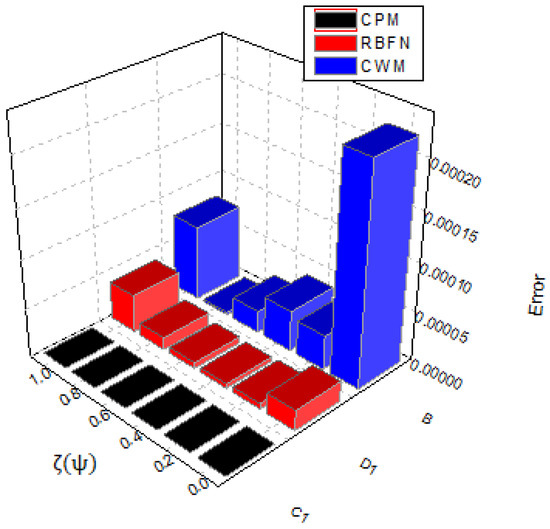
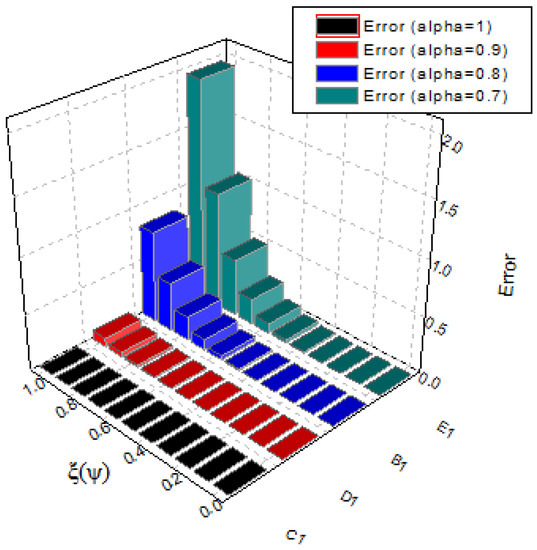
Consider the following fractional integral equation nonlinear system
with the exact solution
In Table 1, we present the accurate and numerical results obtained by implementing the suggested approach and the results obtained by CWM while Table 2 shows the absolute error comparison of the suggested approach and results obtained through CWM at and the radial basis function network (RBFN) at . Figure 1 and Figure 2 show the behavior of the exact solution (E.S) and approximate solution (our technique) of this case when while Figure 3 and Figure 4 show the error comparison of CPM, CWM, and RBFN. Moreover, Figure 5 demonstrate the graphical behaviors of the solutions for various fractional orders, showing that as the value of α moves toward the integer-order from the fractional order, the solution converges to the exact.

Table 1.
Example 1: exact vs. CPM, CWM solution at m = 6.

Table 2.
CPM versus the CWM error comparison at m = 6 of problem 1.

Figure 1.
Example 1 of the solution graph, CPM solution and exact solution for .

Figure 2.
Example 1 of the solution graph, CPM solution and exact solution for .

Figure 3.
Our method, CWM, and RBFN error graph for Example 1.

Figure 4.
Our method, CWM, and RBFN error graph for Example 1.

Figure 5.
At different fractional orders, the absolute error graph of Example 1.
Example 2.


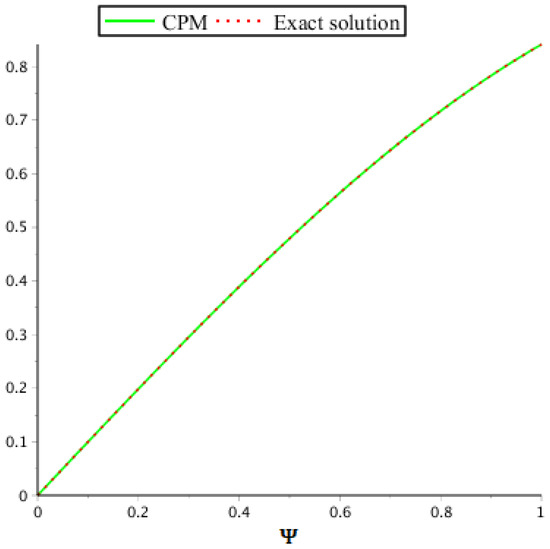

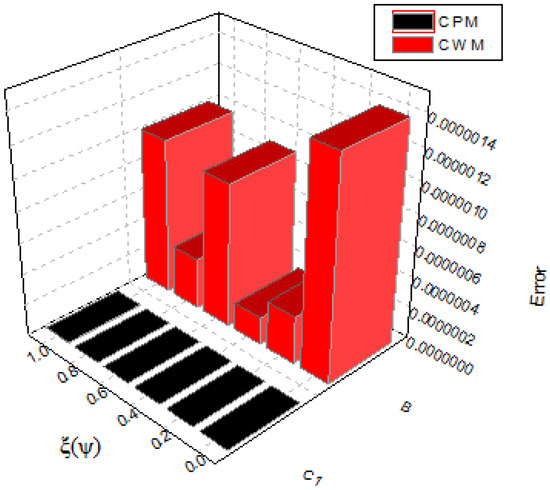
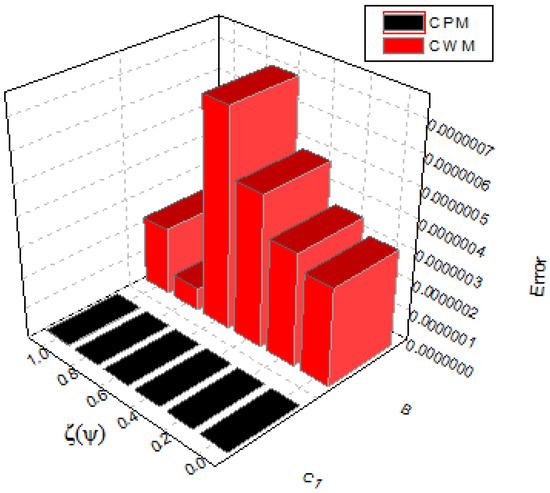
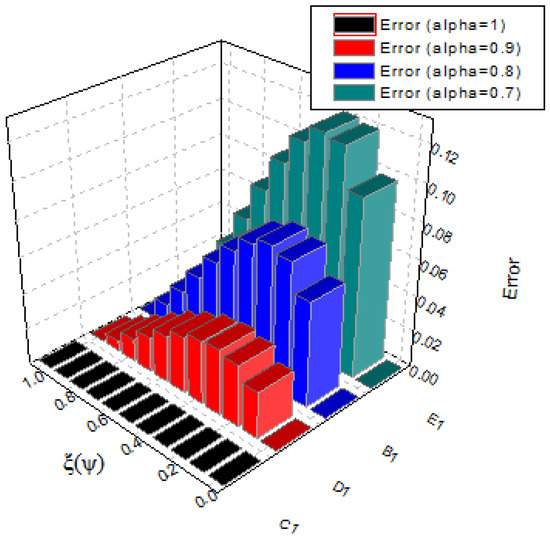
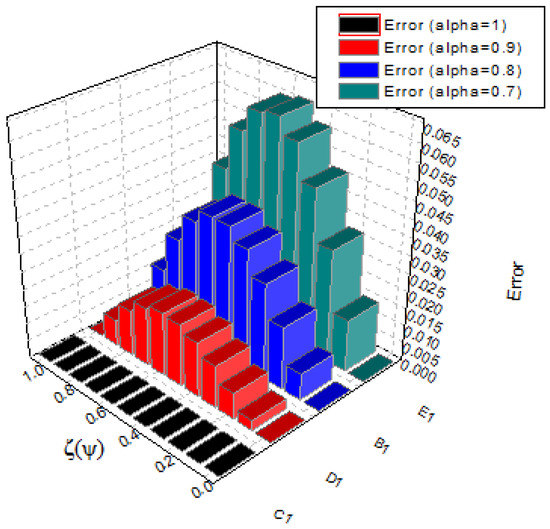
Consider the following fractional integral equation nonlinear system
with the exact solution
The accurate and numerical results obtained by implementing the suggested approach and results obtained by CWM for are shown in Table 3. In Table 4, the errors implemented by the current approach are compared to those acquired by CWM. In Figure 6 and Figure 7, we compare the accurate results with our method’s results, showing that they are very near to each other. Moreover, Figure 8 and Figure 9 illustrate the CPM and CWM error comparisons, showing that CPM is in good agreement with the exact results, whereas Figure 10 and Figure 11 show graphical representations of the solutions for various fractional orders.

Table 3.
Problem 2: exact vs. CPM; CWM solution at m = 6.

Table 4.
CPM versus the CWM error comparison at m = 6 of problem 2.

Figure 6.
Example 2: CPM solution and exact solution for .

Figure 7.
Problem 2: CPM solution and exact solution for .

Figure 8.
Our method and the CWM error graph for Example 2.

Figure 9.
Our method and the CWM error graph for Example 2.

Figure 10.
At different fractional orders, the absolute error graph of Example 2.

Figure 11.
At different fractional orders, the absolute error graph of Example 2.
Example 3.


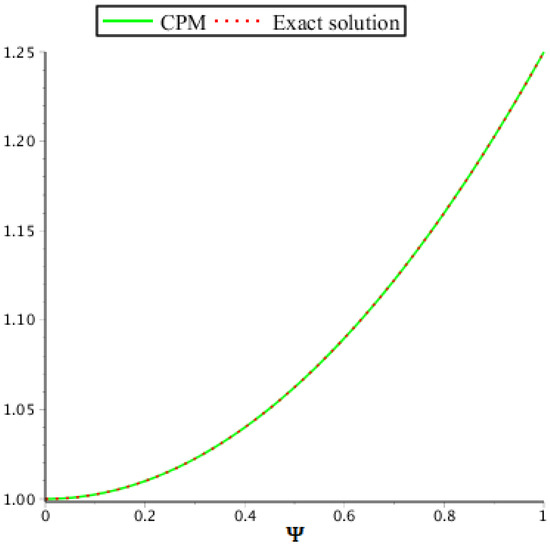

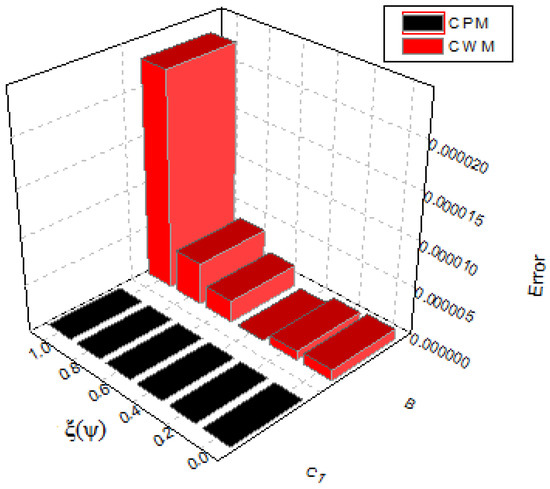
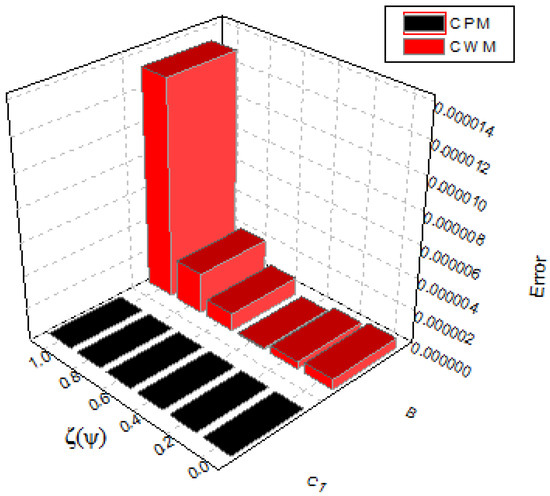
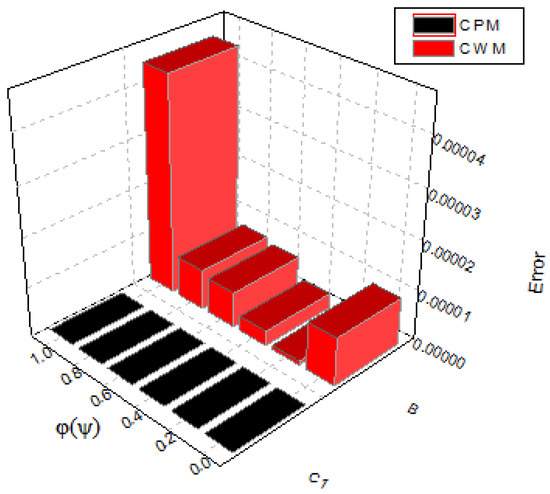
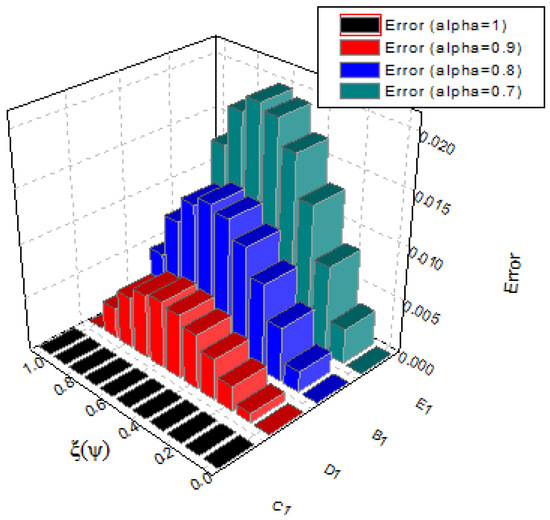
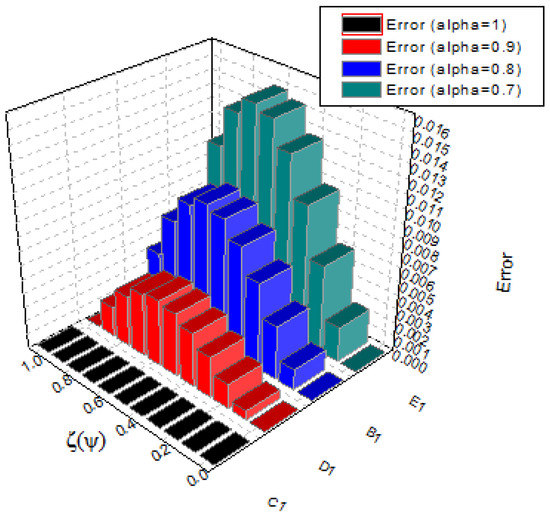
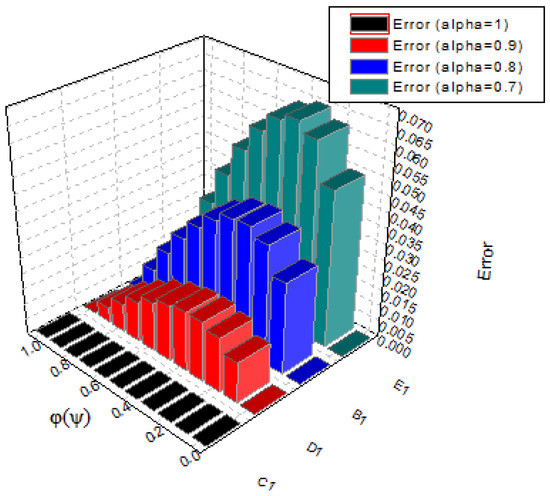
Consider the following fractional integral equation nonlinear system:
with the exact solution We use the technique described in Section 2 for with to solve this problem. Table 5 shows the exact and CPM estimated solutions. Table 6 compares the absolute error of our technique to that of CWM. The results of the proposed technique are in good agreement with the exact results, as shown in Figure 12 and Figure 13. The error comparison between CPM and CWM is provided in Figure 14, Figure 15 and Figure 16 to demonstrate the usefulness of CPM. In addition, in Figure 17, Figure 18 and Figure 19 we can see the estimated solutions for the various fractional orders.

Table 5.
Problem 3: exact vs. CPM solution at m = 6.

Table 6.
CPM versus the CWM error comparison at m = 6 of problem 3.

Figure 12.
Example 3: CPM solution and exact solution for .

Figure 13.
Example 3: CPM solution and exact solution for .

Figure 14.
Our method and the CWM error graph for Example 3.

Figure 15.
Our method and the CWM error graph for Example 3.

Figure 16.
Our method and the CWM error graph for Example 3.

Figure 17.
At different fractional orders, the absolute error graph of Example 3.

Figure 18.
At different fractional orders, the absolute error graph of problem 3.

Figure 19.
At different fractional orders, the absolute error graph of Example 3.
5. Conclusions
In this article, we find the solutions to nonlinear fractional equation systems by implementing the Chebyshev pseudo-spectral method. This type of problem is reduced to the solution of a system of linear and nonlinear algebraic equations using the method proposed. The solutions obtained by utilizing the suggested approach are in good agreement with the actual results and are more accurate than those of other methods. Moreover, it can be confirmed from the figures and tables that our method’s error quickly converges compared to other techniques. Maple was used to perform the calculations in this article.
Author Contributions
Conceptualization, J.D.C.; Methodology, M.N.; Software, P.S.; Formal analysis, M.N. and N.A.S.; Investigation, J.D.C.; Data curation, N.A.S.; Writing—original draft, P.S. and R.S.; Writing—review & editing, J.D.C. All authors have read and agreed to the published version of the manuscript.
Funding
This research received no external funding.
Institutional Review Board Statement
Not applicable.
Informed Consent Statement
Not applicable.
Data Availability Statement
Not applicable.
Acknowledgments
The authors would like to thank the Deanship of Scientific Research at Umm Al-Qura University for supporting this work under Grant Code number: 22UQU4310396DSR37.
Conflicts of Interest
The authors declare no conflict of interest.
References
- Bisquert, J.; Garcia-Belmonte, G.; Fabregat-Santiago, F.; Compte, A. Anomalous transport effects in the impedance of porous film electrodes. Electrochem. Commun. 1999, 1, 429–435. [Google Scholar] [CrossRef]
- Alaoui, M.K.; Fayyaz, R.; Khan, A.; Shah, R.; Abdo, M.S. Analytical investigation of Noyes-Field model for time-fractional Belousov-Zhabotinsky reaction. Complexity 2021, 2021, 1–21. [Google Scholar] [CrossRef]
- Reyes-Melo, E.; Martinez-Vega, J.; Guerrero-Salazar, C.; Ortiz-Mendez, U. Application of fractional calculus to the modeling of dielectirc relaxtion phenomena in polymetric materials. J. Appl. Polym. Sci. 2005, 98, 923. [Google Scholar] [CrossRef]
- Picozzi, S.; West, B.J. Fractional Langevin model of memory in financial market. Phys. Rev. E 2002, 66, 046118. [Google Scholar] [CrossRef]
- Henry, B.I.; Wearne, S.L. Existance of Turing instabilities in a two-species fractional reaction-diffusion system. SIAM J. Appl. Math. 2002, 62, 870. [Google Scholar] [CrossRef]
- Xie, Z.; Feng, X.; Chen, X. Partial least trimmed squares regression. Chemom. Intell. Lab. Syst. 2022, 221, 104486. [Google Scholar] [CrossRef]
- Kovalnogov, V.N.; Fedorov, R.V.; Karpukhina, T.V.; Simos, T.E.; Tsitouras, C. Sixth Order Numerov-Type Methods with Coefficients Trained to Perform Best on Problems with Oscillating Solutions. Mathematics 2021, 9, 2756. [Google Scholar] [CrossRef]
- Shao, Z.; Zhai, Q.; Han, Z.; Guan, X. A linear AC unit commitment formulation: An application of data-driven linear power flow model. Int. J. Electr. Power Energy Syst. 2023, 145, 108673. [Google Scholar] [CrossRef]
- Mandelbrot, B. Some noises with i/f spectrum, a bridge between direct current and white noise. IEEE Trans. Inf. Theory 1967, 13, 289–298. [Google Scholar] [CrossRef]
- Baillie, R.T. Long memory processes and fractional integration in econometrics. J. Econom. 1996, 73, 5–59. [Google Scholar] [CrossRef]
- He, J.H. Nonlinear oscillation with fractional derivative and its applications. In Proceedings of the International Conference on Vibrating Engineering, Dalian, China, 6–9 August 1998; Volume 98, pp. 288–291. [Google Scholar]
- Magin, R.L. Fractional calculus in bioengineering, part 1. Crit. Rev. Biomed. Eng. 2004, 32, 1–104. [Google Scholar] [CrossRef] [PubMed]
- Vinagre, B.M.; Podlubny, I.; Hernandez, A.; Feliu, V. Some approximations of fractional order operators used in control theory and applications. Fract. Calc. Appl. Anal. 2000, 3, 231–248. [Google Scholar]
- Smit, W.; De Vries, H. Rheological models containing fractional derivatives. Rheol. Acta 1970, 9, 525–534. [Google Scholar] [CrossRef]
- Cuesta, E.; Fernandez-Manso, A.; Quintano, C. Generalized fractional integrals in advanced remote sensing. In Proceedings of the 2016 12th IEEE/ASME International Conference on Mechatronic and Embedded Systems and Applications (MESA), Auckland, New Zealand, 29–31 August 2016; pp. 1–4. [Google Scholar]
- Salo, M.; Tuusa, H. A vector controlled current-source pwm rectifier with a novel current damping method. IEEE Trans. Power Electron. 2000, 15, 464–470. [Google Scholar] [CrossRef]
- Metzler, R.; Schick, W.; Kilian, H.-G.; Nonnenmacher, T.F. Relaxation in filled polymers: A fractional calculus approach. J. Chem. Phys. 1995, 103, 7180–7186. [Google Scholar] [CrossRef]
- Areshi, M.; Khan, A.; Shah, R.; Nonlaopon, K. Analytical investigation of fractional-order Newell-Whitehead-Segel equations via a novel transform. AIMS Math. 2022, 7, 6936–6958. [Google Scholar] [CrossRef]
- Zidan, A.M.; Khan, A.; Shah, R.; Alaoui, M.K.; Weera, W. Evaluation of time-fractional Fishers equations with the help of analytical methods. AIMS Math. 2022, 7, 18746–18766. [Google Scholar] [CrossRef]
- Alyobi, S.; Shah, R.; Khan, A.; Shah, N.A.; Nonlaopon, K. Fractional Analysis of Nonlinear Boussinesq Equation under Atangana-Baleanu-Caputo Operator. Symmetry 2022, 14, 2417. [Google Scholar] [CrossRef]
- Sunthrayuth, P.; Alyousef, H.A.; El-Tantawy, S.A.; Khan, A.; Wyal, N. Solving Fractional-Order Diffusion Equations in a Plasma and Fluids via a Novel Transform. J. Funct. Spaces 2022, 2022, 1899130. [Google Scholar] [CrossRef]
- Shah, N.A.; El-Zahar, E.R.; Akgul, A.; Khan, A.; Kafle, J. Analysis of Fractional-Order Regularized Long-Wave Models via a Novel Transform. J. Funct. Spaces 2022, 2022, 2754507. [Google Scholar] [CrossRef]
- Liu, K.; Yang, Z.; Wei, W.; Gao, B.; Xin, D.; Sun, C.; Wu, G. Novel detection approach for thermal defects: Study on its feasibility and application to vehicle cables. High Volt. 2022, 1–10. [Google Scholar] [CrossRef]
- Liu, P.; Shi, J.; Wang, Z.-H. Pattern formation of the attraction-repulsion Keller-Segel system. Discret. Contin. Dyn. Syst.-B 2013, 18, 2597–2625. [Google Scholar] [CrossRef]
- Wang, H.; Fu, H.M.; Zhang, H.F.; Hu, Z.Q. A practical thermodynamic method to calculate the best glass-forming composition for bulk metallic glasses. Int. J. Nonlinear Sci. Numer. Simul. 2007, 8, 171–178. [Google Scholar] [CrossRef][Green Version]
- Xu, L.; He, J.H.; Liu, Y. Electrospun nanoporous spheres with Chinese drug. Int. J. Nonlinear Sci. Numer. Simul. 2007, 8, 199–202. [Google Scholar] [CrossRef]
- Sun, F.Z.; Gao, M.; Lei, S.H.; Zhao, Y.; Wang, K.; Shi, Y.T.; Wang, N.H. The fractal dimension of the fractal model of dropwise condensation and its experimental study. Int. J. Nonlinear Sci. Numer. Simul. 2007, 8, 211–222. [Google Scholar] [CrossRef]
- Bo, T.L.; Xie, L.; Zheng, X.J. Numerical approach to wind ripple in desert. Int. J. Nonlinear Sci. Numer. Simul. 2007, 8, 223–228. [Google Scholar] [CrossRef]
- Diethelm, K.; Ford, N.J.; Freed, A.D. Detailed error analysis for a fractional adams method. Numer. Algorithms 2004, 36, 31–52. [Google Scholar] [CrossRef]
- Diethelm, K.; Ford, N.J. Analysis of fractional differential equations. J. Math. Anal. Appl. 2002, 265, 229–248. [Google Scholar] [CrossRef]
- Hashim, I.; Abdulaziz, O.; Momani, S. Homotopy analysis method for fractional ivps. Commun. Nonlinear Sci. Numer. Simul. 2009, 14, 674–684. [Google Scholar] [CrossRef]
- Odibat, Z.; Momani, S.; Erturk, V.S. Generalized differential transform method: Application to differential equations of fractional order. Appl. Math. Comput. 2008, 197, 467–477. [Google Scholar] [CrossRef]
- Brunner, H.; Makroglou, A.; Miller, R.K. Mixed interpolation collocation methods for first and second order volterra integro-differential equations with periodic solution. Appl. Numer. Math. 1997, 23, 381–402. [Google Scholar] [CrossRef]
- Rawashdeh, E.A. Numerical solution of fractional integro-differential equations by collocation method. Appl. Math. Comput. 2006, 176, 1–6. [Google Scholar] [CrossRef]
- Volk, W. The iterated galerkin method for linear integro-differential equations. J. Comput. Appl. Math. 1988, 21, 63–74. [Google Scholar] [CrossRef]
- Pedas, A.; Tamme, E. Spline collocation method for integro-differential equations with weakly singular kernels. J. Comput. Appl. Math. 2006, 197, 253–269. [Google Scholar] [CrossRef][Green Version]
- Yousefi, S.; Razzaghi, M. Legendre wavelets method for the nonlinear volterra-fredholm integral equations. Math. Comput. Simul. 2005, 70, 1–8. [Google Scholar] [CrossRef]
- Atangana, A.; Araz, S.I. New numerical approximation for Chua attractor with fractional and fractal-fractional operators. Alex. Eng. J. 2020, 59, 3275–3296. [Google Scholar] [CrossRef]
- Mekkaoui, T.; Atangana, A.; Araz, S.I. Predictor-corrector for non-linear differential and integral equation with fractal-fractional operators. Eng. Comput. 2021, 37, 2359–2368. [Google Scholar] [CrossRef]
- Subasi, M.; Araz, S.I.; Gungor, H. On the numerical solution of two dimensional Schrodinger equation. Int. J. Math. Res. 2017, 6, 1–12. [Google Scholar] [CrossRef][Green Version]
- Nonlaopon, K.; Alsharif, A.M.; Zidan, A.M.; Khan, A.; Hamed, Y.S.; Shah, R. Numerical investigation of fractional-order Swift-Hohenberg equations via a Novel transform. Symmetry 2021, 13, 1263. [Google Scholar] [CrossRef]
- He, J.H.; Li, Z.B.; Wang, Q.L. A new fractional derivative and its application to explanation of polar bear hairs. J. King Saud-Univ.-Sci. 2016, 28, 190–192. [Google Scholar] [CrossRef]
- Sunthrayuth, P.; Ullah, R.; Khan, A.; Shah, R.; Kafle, J.; Mahariq, I.; Jarad, F. Numerical analysis of the fractional-order nonlinear system of Volterra integro-differential equations. J. Funct. Spaces 2021, 2021, 1537958. [Google Scholar] [CrossRef]
- Sweilam, N.H.; Khader, M. A Chebyshev pseudo-spectral method for solving fractional-order integro-differential equations. ANZIAM J. 2010, 51, 464–475. [Google Scholar] [CrossRef]
Publisher’s Note: MDPI stays neutral with regard to jurisdictional claims in published maps and institutional affiliations. |
© 2022 by the authors. Licensee MDPI, Basel, Switzerland. This article is an open access article distributed under the terms and conditions of the Creative Commons Attribution (CC BY) license (https://creativecommons.org/licenses/by/4.0/).